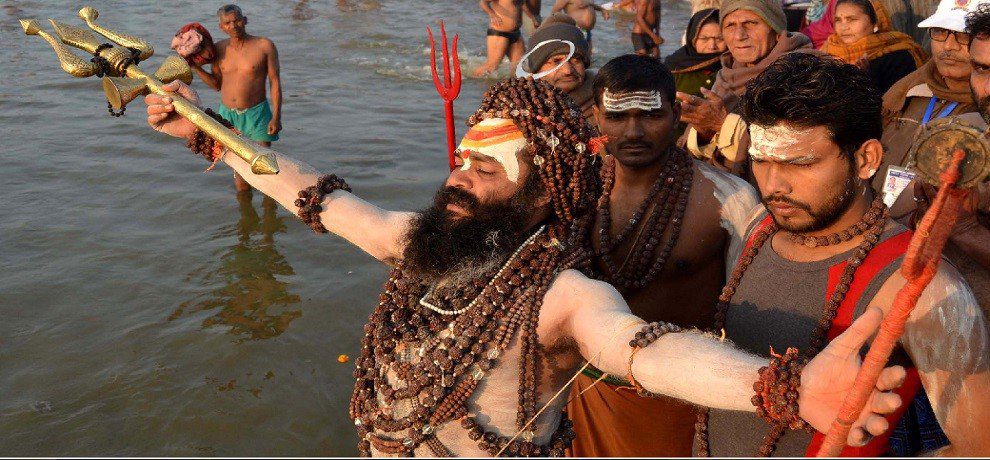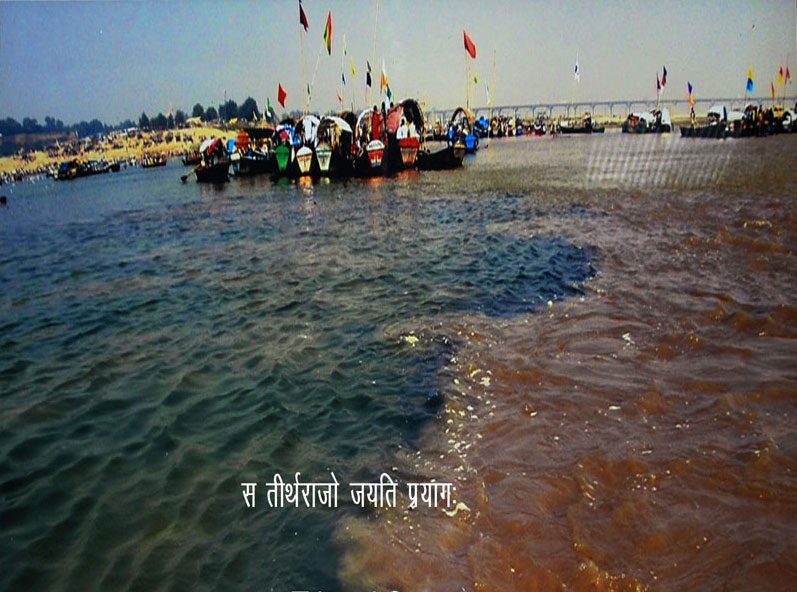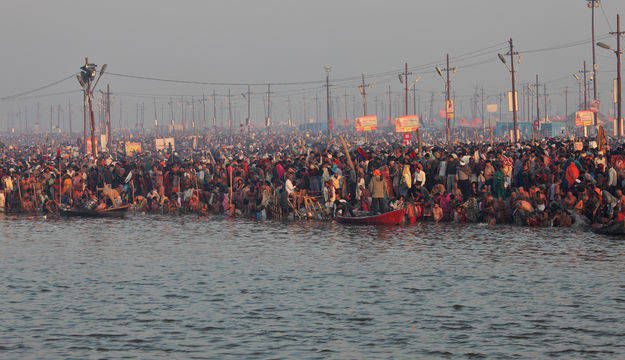Makar Sankranti-One festival many names

Makar Sankranti / Khichadi /Maghi / Uttarayan / Pongal /Bhogali Bihu ( मकर संक्रांति /खिचड़ी / माघी / उत्तरायण / पोंगल / भोगाली बिहू )
Date in 2018 – 14 January 2018, Day- Sunday
Panchang Tithi- Magh Krishn 13
Nakshatra- Jyeshtha
Chandra- Dhanu(Sagittarius)
Makar Sankranti is one of the most important festivals in India.It is known by different name across different regions in India like Makar Sankranti, Khichadi, Maghi ,Uttarayan, Pongal, Bhogali Bihu. Recently it has acquired as new name in distant parts of the globe as ‘The largest kite festival on earth’. Though this may not be far from the truth as kite flying are one of the most important part for this festival. People cite various reasons for this as staying in open while flying kite will expose you to sunlight and thus health benefits Actually after the cold winters this is day when you would actually feel the temperature difference in atmosphere and find weather a bit warmer than previous day. It’s very subtle but it can be felt definitely.
Although Makar Sankranti is known by different names in some parts but the reason behind the celebration is common; that is transcendence of Sun into Capricorn zodiac (Capricorn is called Makar in Hindi Zodiac) from Sagittarius zodiac & start of Uttarayana phase as per ancient Hindu scriptures.
We shall talk about this start date of Uttarayan in more detail below though.

What is Makar Sankranti:
Makar means Capricorn and Sankranti comes from the Sanskrit word ‘Sankraman’ which means crossing the boundaries and enter into some other turf. There are twelve Sankrantis in as as per Hindu calendar as Sun traverses into 12 zodiacs across the year. Zodiacs are twelve in number and are divided on the Earth’ s revolution path around the Sun. These are namely Aries, Taurus, Gemini, Cancer, Leo, Virgo, Libra, Scorpio, Sagittarius, Capricorn, Aquarius, Pisces.
There is a sankranti every month when the sun passes from one sign of the zodiac to the next. Since there are twelve signs of the zodiac as described above, and thus there are twelve sankranti’s as well. Each of these sankranti’s has its own relative importance but two of these are more important – the Mesh (Aries) Sankranti and the most important, the Makar (Capricorn) Sankranti. Mesh Sankranti is a new year start in hindi calendar.
However we celebrate Makar Sankranti as a special festival as this is considered very auspicious because of various reasons.
The Puranas say that on this day Sun visits the house of his son Shani, who is the Lord of Makar-Capricorn Rashi. These father & son do not ordinarily get along nicely, but in spite of any difference between each other Lord Sun makes it a point to meet each other on this day. Father in fact himself comes to his son’s house, for a month. This day symbolized the importance of special relationship of father & son.
It was on this day when Lord Vishnu ended the ever increasing terrorism of the Asuras by finishing them off and burying their heads under the Mandar Parvat. So this occasion also represents the end of negativities and beginning of an era of righteous living.
The great savior of his ancestors, Maharaj Bhagirath, did great Tapasya to bring Gangaji down on the earth for the redemption of 60,000 sons of Maharaj Sagar, who were burnt to ashes at the Kapil Muni Ashram, near the present day Ganga Sagar. It was on this day that Bhagirath finally did tarpan with the Ganges water for his unfortunate ancestors and thereby liberated them from the curse. After visiting the Patala for the redemption of the curse of Bhagirath’s ancestors Gangaji finally merged in the Sagar. Even today a very big Ganga Sagar Mela is organized every year on this day at the confluence of River Ganges and the Bay of Bengal. Lakhs take dip in the water and do tarpan for their ancestors.
Another well-known reference of this day came when the great grandsire of Mahabharata fame, Bhishma, declared his intent to leave his mortal coil on this day. He had the boon of Ichha-Mrityu from his father, so he kept lying on the bed of arrows till this day and then left his mortal coil on Makar Sankranti day. It is believed that the person, who dies during the period of Uttarayana, becomes free from transmigration. So this day was seen as a sure-shot Good Luck day to start your journey or endeavors to the higher realms beyond.
Concept of Uttarayan -Dakshinayan:
Uttarayan and Winter Solstice:
In northern hemisphere, Winter Solstice is the time when the southern hemisphere of the earth is tilted towards the sun at it’s maximum value. Winter Solstice currently occurs every year December 21. After this, the earth starts tilting in the opposite direction until the Summer Solstice. Thus, winter solstice is the beginning of Northward movement of sun, which in India, we call as Uttarayan.
Technically, Uttarayan happens on 21st / 22nd Dec & Makar Sankranti is the day when the Sun enters the Capricorn Constellation. This generally happens on 14th / 15th January these days, but this date is slowly changing. 1000 yrs back the phenomenon of the Makar sankranti used to happen on around 31st December & 1000 yrs from now, it’ll happen on 31st January.
Therefore, Makar Sankranti is not the date when sun starts it’s Northward journey. Actually Uttarayan has already started from around 21st December, the day of winter solstice.
Then why do we use Uttarayan as an alternate term for Makar Sankranti?
Winter Solstice shifts back one day every 70 years due to axial precession of earth. Therefore, around 1500-2000 years ago i.e. during the era of great mathematicians and astronomers in India, the winter solstice used to take place on on same day of Makar Sankranti (now it falls on around January 13-15 ) and the Sun was entering in the constellation Capricorn on this date.
So around 1500-2000 years back , the Makar sankranti & Uttarayan used to coincide around 21st Dec.Hence, we celebrated Makar Sankranti and Uttarayan on this date and they continue to be used as an alternate term till today. In fact that the Makar sankranti date 14 January is changing continually, so around 1000 years back it used to be around 31 December. So the exact coincidence of Sankranti and Uttarayan may have somewhere in between 21 Dec to 14 January.
Tropic of Capricorn and Makar Sankranti
Tropics are geographical zones of earth divide into five parts namely North pole, Tropic of Capricorn, Tropic of Cancer, Antarctic Circle, South Pole.
During winter solstice(on 21 December) , the angle at which the earth is titled is currently equal to 23 degree 26 minute (approx). Therefore the latitude at 23 degree 26 minute finds the Sun directly overhead on this day. Around 2000 years ago, on the day of Winter Solstice, the sun was directly in the direction of the zodiac of Capricorn (Makar), hence the latitude is now known as Tropic of Capricorn. However, nowadays the sun appears in the direction of Sagittarius at this time. This is also to be noted that the Tropic of Capricorn itself is not fixed. It is currently shifting northward at the rate of 0.47 arc seconds per year.

Therefore on Makar Sankranti not only the Sun is already in Uttarayan (Sun has already started its northward journey-Uttarayan, on 21st December-The day of winter solstice) but Sun also enters the constellation of Capricorn (Makara Rashi). And hence the festival is celebrated.
Are the day and night of equal length on Makar Sankranti?
Another common myth is that the day and night on Makar Sankranti are of equal length. This however is not at all true. The length of day and night are equal on the special days called Equinoxes. These occur twice every year on around March 21 and September 23.
As per dharmic scriptures ,it is believed that Uttarayan is the DAY for the Gods(Devas) while the other half Dakhsinayan is considered the NIGHT of Devas. Uttarayana is also called as Devayana, and the next half-Dakhsinayan is also called Pitrayana.

Good events like marriage, house purchase are kept on hold for a month before Makar sankanti. Thisone month period before Makar Sankranti is called ‘Khar mas’ and good events are kept on hold during this period.
It is written in Mahabharata that Bhishma Pitamah had the boon of Ichchha Mrityu (Death as per wish) and he left his body only when Sun came into Uttarayan. This is a testimony to why this Makar Sankranti and Uttarayan period is considered highly auspicious.
One of the most Holy book of Hindus “Gita” which is direct narration from Lord Krishna voice, it is cleared mentioned that six months duration of Uttarayan is the day time of Devas & remaining six months of Dakhshinayan is the night for Gods. It is said that if the person leaved his mortal body in Uttarayan can attain ‘Krishna Lok’. While the one who dies in Dakhshinayan, has to be reborn to get rid of his Karma debt.
Saturn is the lord of Capricorn zodiac. Saturn is also the son of God Sun. Relationship between Saturn and Sun is inimical however it is believed the during Makar Sankranti Sun forgives his son and comes to meet him in his zodiac sign of Capricorn. So this is also said to be the time when people should forget their enmity with others an should try to be friends again.People forget their past grievances and forgive one another on this day.There is famous saying in Indian state of Maharashtra on this day
“Til gud gheya, gud gud bola”… ” Eat Sesame and Jaggery and talk sweet like jaggery”

Bath in Pilgrimages:
It is the day when taking bath in holy waters at pilgrimages and rivers etc is considered highly meritorious. Any religious or good act done on this day is said to bring you back result many fold in later on births. Most prominent religious places where people throng upon to take bath are Sangam at Prayag (City :Prayagraj now), Haridwar, Kurukshetra, Gangasagar.


It is said ,
“Sare tirath bar bar , Gangasagar ek baar” All other pilgrimages have to done repeatedly while Gangasagar only once”…why?

Makarsankranti is the day when holy river Gangaji merged into sea ( Bay of Bengal) at Gangasagar. Gangaji came to earth after a great penance done by King Bhagirath because his ancestor King Sagar’s sixty thousand sons were burnt to ashes because of a curse from Kapil Muni, who was doing penance at Ganagasagar place at that time. It was said that they could be liberated only when Gangaji from heavens comes to earth and wash their ashes when only they will achieve salvation. Bhagirath did everything he could and brought Gangaji to earth from heavens. After travelling from Himalaya and going through treacherous trajectories she finally reached sea this day and liberated the sixty thousand sons of King Sagar. That is why taking bath in Ganagasagar on MakarSankranti is considered so auspicious.
It is also the day when thousands of pilgrims gather at the Sabarimala Temple to witness the makarjyothi in southern part of India
Importance of Sesame seeds(Til):
Til is given huge importance on the festival and considered to bring great health benefits to those who eat this today. Sesame or til which holds special significance on Makar Sankranti is considered as the grain par excellence and is eaten and given away in alms and gift. As per Hindu mythology the god Yama blessed the sesame seed and hence they are regarded as the symbols of immortality. The seed was supposed to have originated when drops of sweat trickled from Vishnu and fell on earth.

Sesame seed is considered symbol of immortality also because of the fact that it is tolerant to drought-like conditions, and it even grows in areas where other crops fail.
Why sesame was considered super healthy and fit to be eaten on Sankranti the major change of Sun’s path both in zodiac and tropical. Til, Teel or Sesame is one of the oldest oilseeds known to humanity. It originated from India. Til or sesame has been a part of rituals since ancient times in our vedic culture. Here are some astonishing facts about sesame which shows why sesame holds so much significance in our vedic culture and Sanatan dharma rituals. Consider these nutritional facts derived by science to prove the validity of the above practice::
- For a 100-gram serving, dried whole sesame seeds are rich in calories (573 kcal) and are composed of 5% water, 23% carbohydrates, 12% dietary fiber, 50% fat and 18% protein.
- The flour that remains after oil extraction from sesame seeds is 35-50% protein and contains carbohydrates.
- Sesame is a rich source of vitamins, minerals, healthy oils. It contains calcium, iron, magnesium, phosphorous, manganese, copper, zinc, fiber, thiamin, vitamin B6 and folate. It is also a good source of protein.”
- Sesame seeds are rich in fiber and they are very helpful in keeping your digestive system healthy .It keeps your colon clean and maintain healthy functioning of the intestines.
- Sesame seeds being rich in copper and anti-oxidants help relieve pain and swelling associated with arthritis.
- It also contains Magnesium which gives relief against respiratory disease and asthma.
- It is also rich in zinc and calcium and thus maintains good bone health.
- Being rich in protein, sesame is a great source of protein for vegetarians.
- Sesame seeds also helps in lowering the bad cholesterol & increases the HDL the good cholesterol in the body. as it has high percentage of monounsaturated fatty acid & folic acid.

Sesame seeds have a higher capacity to absorb spiritual purity (Satva gun) and they remove the spiritually impure component (Raja & Tama gun). The benefits of this are that the seeker gains spiritual purity (Satva )by eating and offering sesame seeds to others .That’s why it is considered important from health as well as from spiritual progress point of view both.
Since sesame seed are supposed to have greater at absorbing the Satva energy and deflecting away Rajas and Tamas, these are considered to facilitate better spiritual progress of the person along with the health benefits as the oil, minerals and vitamins aid the prevention of cold and upcoming change of weather. Shashtras have prescribed various ways of facilitating the maximum use of sesame seed. It is said that one should put sesame oil before bath and use water containing sesame seeds, eat and distribute sweets containing sesame seeds to Brahmans, friends, acquaintances , guest or just donate to as many as possible. , Light lamps of sesame oil in temples and at home. perform shradh rites for departed ancestors (Pitars) by using sesame in water offering to them or making rice or wheat flour ball mixed with sesame seeds. The use of sesame in an offering to ancestors , given them immense satisfaction and prevents one from the negative forces and give the blessings of Pitars.
Renouncement Old, Welcome New:
In Punjab, Haryana they celebrate Lohri a day before Makar Sankranti. They lite bonfire and sing and dance throughput the night. It is supposed to be denouncement of old things and welcoming new . How symbolic: as far off in South India they celebrate ‘Bhogi’ — a day when the old — old possessions (like clothes, utensils etc ) which are no longer useful are thrown away or given to those who need it. Also you need to abandon your old thoughts which inhibit growth and move towards the new progressive thoughts which takes you to greater heights in life..
Makar Sankranti, with it different name in all states is primarily a festival of welcoming the change, abandoning the old, and the start of the harvesting festivals. That’s why all the celebration. The new crops which are ripe are harvested and relished as well shared with loved ones. Warm winter foods like sesame seed and fresh jaggery are delicacies people relish and are available when our body needs them most in chilly winters.
People from UP & Bihar eat Khichari, chuda ,curd on this day along with sesame seed laddoos and sweets made from jaggery.
In Gujarat & Maharashtra people eat sesame seed laddoos and sweets made from jaggery and fly Kites.

Why do people fly kites on this day:
- Earlier people used to fly kite early in morning in open space or on their roofs. Early morning sun shine is great source of vitamin D. It is is also great to assimilate the vitamins and nutrients consumed on this day with special preparation.
- Also the kites were supposed to be an offering to the Sun God.
- Mind is relaxed when you look at the sky and its a refreshing experience for the people.
- Kite flying is a uplifting activity for many youngsters.

Makar sankranti is one of those festivals which falls around the same date on 14 January every year. Usually Indian festivals follow lunar calendar and fall on different dates every year. But this one is an exception because it is a solar event and dependent on the Sun rather than movement of Moon. However this fixed date also changes due to variation in polar movement of Earth .Which requires the date to be adjusted over period of years.
During King Harshvardhana (590–647 CE) time on 24 December. During Akbar’s time in (around 1546 CE) it used to fall on 10 January, During King Shivaji’s time in ( around 1750’s) it used to fall on 11 January.
Makar Sankranti, which is being celebrated on January 14 for the last 100 years or so , will change it date and would be celebrated on 15 January from the year 2019 in 2021
The duration of day and night on Makar Sankranti is equal. However from this day onward the day start getting longer and nights start getting shorter .One can feel days start getting warmer from today.

Sankranti Devi:
Sankranti(An incidence) like Ekadashi ( which is 11th day of Lunar fortnight) is a Deity as well. She assumes a female form and has her clothes as Black,Red or white.Her vehicle as Elephant or other animals as lesser preferred ones. She has Bow and Spear in her hands .She comes from East direction and goes to west direction and looks in third direction.
Whatever she accepts that is destroyed or the prices go up for that commodity. The direction from where she goes from becomes happy while the direction in which she goes that becomes unhappy. Her disposition and deliverance changes as per the requirement of time. The day followed by Makar sankranti is referred as Kinkrant or Karidin. On this day, the Sankranti Devi slayed the demon Kinkarasur.
Also on this auspicious day Maa Durga, with the purpose of destroying Mahishasur, first set foot on earth, in the Kataraaj ashram of Rishi Kardam and Devahuti.
Importance of haldi-kumkum ceremony performed by married women on Makar Sankranti :
Performing haldi-kumkum (Turmeric powder and vermilion) ceremony is in a way invoking the waves of dormant Adi-shakti in the Universe to get activated. This helps in creating impression of Sagun (Materialised) devotion on the mind of an individual and enhances his bhav (Spiritual emotion) unto God.
Makar Sankranti is day when many people start their pilgrimage journey as well. Kumbh Mela at Prayag Sangam starts from this day . Fairs are held at Prayag, Gangasagar, Tusu mela in Jharakhand and some parts of west bengal and many other fairs are held from this Makar Snkranti day onwards across India.
There is an old story that that Mata Yashoda kept fast on this day to get Shri Krishna as her son. Even today ladies perform ‘Dahi Manthan’ (Curd churning) on this day to beget a son like Krishna. A place is chosen and they mark Swastika with vermilion and put rice grain in the middle and then put the curd vessel on it. They churn curd in it and sing praises and songs of Krishna to get their wish fulfilled.It is believed that Kripi , Dronacharya’s wife performed Dahi Mantan ritual and got valorous son like Ashwatthama.
Balochi Marathas still carry out the haldi-kumkum ceremony on Sankranti. This practice is from the time since they settled in Balochistan(Now in Pakistan) in old times.
How to Celebrate:
- Get up early in the morning, before sunrise, have bath and be ready with water & flowers for the sunrise. Worship the rising Sun, by offering water, flowers with both the hands & then pray with folded hands by chanting the Gayatri Mantra and pray for knowledge, wisdom and enlightenment to rise in the similar way to greater & greater heights. Pray for blessings to live a dynamic, inspired & righteous life.
- Do ‘Tarpan’ for your ancestors. Offer water to the ancestors while praying for their blessings. Resolve to redeem the pledges & pride of your forefathers. Live life in such a way that wherever your forefathers may be their head is held high by the life & deeds of their children.
- Have a special session of Meditation, wherein you bring about the awareness of the self-effulgent subjective divinity. Affirm the greatest importance of your spiritual goal very clearly, and pray to God to bless you with the capacity to constantly revel in your true self. May the graph of your rise like the Uttarayana Sun. May there be greater ‘Love & Light’ in your life & the world.
- Prepare laddus or other sweets of Til & Gur and offer them to your friends & relatives. See to it that your ‘Well-being Prayer for all’ gets manifested in action & deeds.
- Have the lunch of Khichiri. This stands for inculcating simplicity in your life & habits.
- Give some Daan on this day to someone who truly deserves.
- Visit your son at his place and give presents to the son and the daughter-in-law. If it is not possible to visit, then organize to send presents to them to express your love & affection to them. Work to properly cultivate the generation, which has to carry forward all the best you cherish & value.
Makar Snkranti is called by different name in Indian subcontinent. Here the list for your reference::
- Makar Sankranti: Chhattisgarh, Goa, Odisha, Bihar, Jharkhand, Andhra Pradesh, Telangana, Karnataka, Kerala, Madhya Pradesh, Maharashtra, Manipur, Rajasthan, Sikkim, Uttar Pradesh, Uttarakhand, Bihar, West Bengal and Jammu
- Thai Pongal, Uzhavar Thirunal: Tamil Nadu
- Uttarayan: Gujarat
- Maghi: Haryana, Himachal Pradesh and Punjab.
- Bhogali Bihu: Assam
- Shishur Saenkraat: Kashmir Valley
- Khichdi: Uttar Pradesh and western Bihar
- Poush Sangkranti: West Bengal
- Tila Sakrait: Mithila
- Makara Sankramana: Karnataka
In other countries too the day is celebrated but under different names and in different ways.
- Bangladesh: Shakrain/ Poush Sangkranti
- Nepal: Maghe Sankranti or Maghi- /Khichdi Sankranti
- Sindh: (Pakistan) Tirmoori
******************************************************************************************************************************************************************************************************************************************************************************************************************************************************
Makar Sankrati bazaar::
US Markets:
Indian Bazaar:
Dibhu.com is committed for quality content on Hinduism and Divya Bhumi Bharat. If you like our efforts please continue visiting and supporting us more often.😀
Tip us if you find our content helpful,
Companies, individuals, and direct publishers can place their ads here at reasonable rates for months, quarters, or years.contact-bizpalventures@gmail.com


























Why do people fly kites on makar Sankranti?
Parvinderji,
Tradition of kite flying is for a healthy exposure in the early morning Sun. These initial rays are healthy and a good source of Vitamin D. It is also considered to be good for skin and helps in fighting many infections and sickness caused by the chilly winter winds.